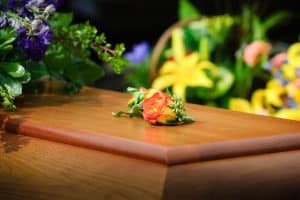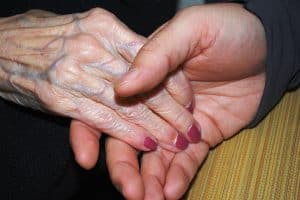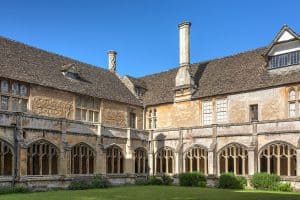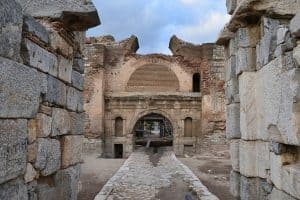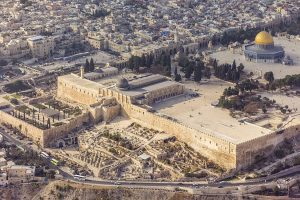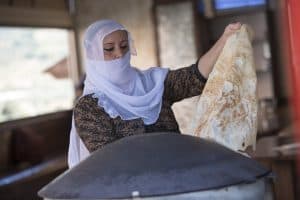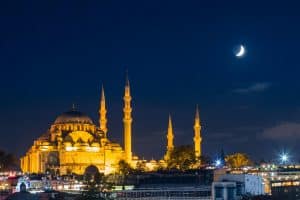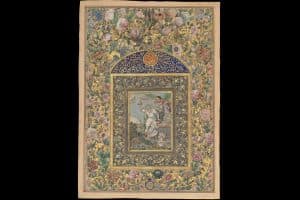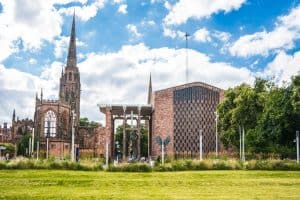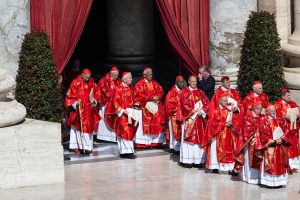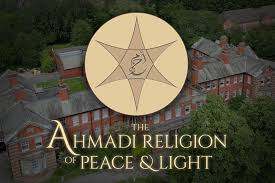Key words, titles and explanations to understand the C of E
People
The Church of England believes in the “threefold order of ministry”, which means there are
three types of clergy: deacons, priests and bishops. You can be a priest only once you have been
ordained a deacon, and you can only become a bishop only if you have been ordained a priest.
Deacons are the first rung on the ladder. They can use the title Reverend, preach and hold
Sunday services, but cannot lead a service of communion and do not usually (but may) conduct
weddings. The vast majority of deacons spend only a year as a transitional deacon before being
ordained priest. A small number remain permanently as deacons, sometimes known as
“distinctive deacons”. They often assist priests in parishes and focus on pastoral work out in the
community.
Priests are the bulk of the clergy in the C of E. After serving one year as a deacon they are
ordained priest and usually continue working in the same church as before. They organise and
lead Sunday services, preach, conduct baptisms, weddings and funerals, and lead services of
communion. Some priests do not work in parish ministry, and can instead become chaplains in
prisons, the military, hospitals or other non-church settings. Others work in academia, C of E
institutions, or take on part-time jobs mixing and matching all of the above. It is a status, not a
job title, so once you are ordained priest you are a priest for life, regardless of if you are actually
in any particular post.
Bishops are the leaders of the C of E. There are about 150 in the Church, all chosen from the
ranks of the priests. Some are diocesan bishops, which means they are in charge of a diocese
and responsible for all the clergy and work going on in that particular geographical region. Most
dioceses also have at least one and as many as four or five suffragan bishops. These are
effectively assistant bishops, who either help the diocesan bishop in running the diocese, or
sometimes are given specific sub-regions in the diocese to look after.
Ordinand While someone is training to become a deacon (and then a priest), they are an
ordinand. There are a wide variety of ways to train: it can be in a traditional residential college,
it could be part-time (coming into a college one or two days a week), or it could be a distance
learning course. Ordinands must undertake theological study, normally a degree, as well as
learning more practical things about how to be a priest. “Mixed-mode” training, where the
ordinand works most of the time for a church, while doing their theological training on the side
part-time, is becoming increasingly popular.
The service at which ordinands become deacons and deacons become priests, is called
ordination. Deacons are normally ordained in a big service once a year in the summer
(Petertide) at each diocese’s cathedral and is led by the bishop. The ordination of deacons as
priests oftens happens in late September (Michaelmas) in a larger church or cathedral.
Curate Once an ordinand has finished their training (which usually takes two or three years),
they must then serve an apprenticeship of three to four years called a curacy, working under a
more experienced priest, called a training incumbent. As a curate, the deacon/priest is expected
to start gradually to take on more responsibility and try the various tasks (preaching, leading
communion, conducting weddings and funerals) of a priest, while also doing some extra training
courses.
Vicar Once the curacy is finished, the priest is now eligible to be appointed to run a parish full
time. The title of this job is usually vicar.
Rector For complicated historical reasons to do with how the medieval church paid its clergy,
which are mostly lost in the mists of time, some parish priests are called rectors instead. There is
no actual difference between the job done by rectors or vicars: it refers only to which particular
parish they have been appointed.
Team rector/team vicar The one exception to this is team ministries, where multiple parishes
are collected into a group. Then one of the priests will become the team rector, who is
nominally in charge of the group. The other technically more junior priests working underneath
them are called team vicars.
Priest-in-charge Another term used for priests running a parish. Again, the actual work done is
exactly the same as a rector or vicar. The only difference is that a priest-in-charge has slightly
less freedom to act as they please, not holding the freehold of the parish, and – unlike rectors
and vicars – they work on a time-limited contract basis for the diocesan bishop.
Stipends Clergy are paid a “stipend” rather than a salary if they are working an ordinary parish
job. It varies in amount from diocese to diocese, but tends to be in the range of £22,000-
£25,000 a year. It is not a salary but an allowance given to cover living costs, as most parish
priests are not employees of the bishop or diocese, but independent office-holders with no
formal contractual obligations. Bishops, deans, archdeacons and archbishops also receive
stipends, which go up with seniority.
Non-stipendiary minister/self-supporting minister Both terms refer to a priest who is not paid
by the C of E. They can be either full-time or part-time, and are mostly older people who have
come into the clergy later in life and do not want or need a salary. They can still have the same
responsibilities and take the same jobs as any other priest.
House for duty Another slightly different way of being an unpaid priest. A house for duty job
means the priest appointed to this parish will not be paid but will be given a house to live in.
Permission to officiate If a priest has retired from full-time work but still wants occasionally to
lead services at churches on behalf of other vicars, they must apply for permission to officiate
from the diocesan bishop. The cadre of retired clergy with permission to officiate are an
essential part of keeping Sunday services going in rural areas, where there are not enough fulltime
clergy to cover every church.
Dean A dean is a priest who is in charge of a cathedral. They act both as spiritual leader,
organising the worship and services, and also as a professional chief executive, running the
dozens (sometimes hundreds) of staff needed to keep these often ancient buildings going.
Rural dean or area dean Nothing to do with a cathedral but a senior priest in a deanery, chairing
the deanery synod and working in support of the archdeacon.
Archdeacon Priests who work as senior members of a diocese’s staff. They act as deputies for
the bishops of the diocese, in particular checking up on the clergy, carrying out various
inspections, offering guidance during vacancies, administering human resources issues, and lots
of other administrative minutiae needed to keep the diocese going.
Archbishop In Anglicanism, an archbishop is the chief bishop of a province. They are the most
senior of all the diocesan bishops and have a number of other institutional roles and
responsibilities. There are two archbishops in the Church of England: the Archbishop of York and
the Archbishop of Canterbury, each in charge of their own province. The Archbishop of York is
also Primate of England, while the Archbishop of Canterbury is Primate of All England (the
whole Church of England) and therefore the senior of the two. Each archbishop is also the
diocesan bishop of a diocese, although most of the day-to-day running of it is delegated to one
of their suffragan bishops.
The religious life The term used for monks and nuns. Members take vows and follow a common
rule. As well as traditional secluded or cloistered communities of monks and nuns, there are a
growing number of more informal and modern groups, whose members may live among
everyone else and work normal jobs.
Reader These are un-ordained lay people, not priests, who are still given some theological
training and licensed to help lead worship, preach at services, and assist in pastoral and
evangelistic work. Often now known as licensed lay ministers (LLMs).
Laity The collective term for everyone who is not ordained as a deacon or priest, i.e. most of us.
The adjective form is “lay”, and currently the Church of England is very exercised about trying to
make sure “lay leadership” is encouraged rather than just letting the priests do everything.
Churchwarden Each parish church is supposed to appoint two members from its congregation to act as churchwardens. They must be elected annually by the church and can normally only serve six years in a row before standing down. Their role is to support the parish priest in running the church, in particular relieving some of the administrative burden. They are particularly important during a clergy vacancy, as they must ensure the worship and life of the church continues while the search for a new priest is carried out.
Places
Parish The smallest geographical sub-division in the C of E. The whole of England is divided into
about 12,500 parishes. Each parish has its own church (occasionally more than one), and has a
priest who is responsible for arranging regular services. With more than 16,000 churches, the
Church has rarely had enough clergy to give every parish its own priest, so it is very common for
priests to be in charge of several churches or parishes at the same time.
Deanery The next level up, a deanery is a group of parishes in a geographic region. Other than
gathering for deanery synod meetings, it is mostly just a way of linking parishes.
Diocese A diocese is a group of deaneries. They are the main geographical sub-divisions of the
Church of England, which has 42 of them, including the Diocese in Europe. They vary
enormously in size but tend to have hundreds of parishes and clergy within each. They are each
legally independent bodies, which have their own staff and operate often quite separately from
other dioceses and the national Church. They each have a diocesan bishop who is in charge, and
normally at least one suffragan bishop assisting them.
Cathedral Each diocese also has at least one cathedral, which is a large church and acts as the
“seat” (hence the name, from the Latin cathedra, or chair) of the diocesan bishop. The cathedral
is effectively the mother church of the diocese, and hosts large events and special services. They
are run by deans, who have complicated relationships with the bishop, who is technically their
boss but actually has little power to interfere in the day-to-day running of the cathedral. There
are also a group of priests and lay people who help the dean, known as the cathedral chapter.
Province This is the next biggest geographical region, encompassing many dioceses and run by
an archbishop. In England, there are two provinces: the province of Canterbury which is all of
the south and the Midlands as far north as Derby, and the province of York, which is basically
the north. Outside of a few technical legal issues, the provinces are not particularly relevant.
The Anglican Communion The Church of England is just one of 40 Anglican churches across the
world. These are mostly, but not exclusively, found in Commonwealth countries and tended to
be started by C of E missionaries during the British Empire. They are all autonomous institutions
but share a common heritage and lots of similar traditions. Sometimes, Anglican churches in
other countries use the name “episcopal” instead. Although each Church is self-governing, the
Archbishop of Canterbury is regarded as the “first among equals” among the archbishops and
the Church of England is the mother Church of the whole communion. There are occasional
gatherings of Anglican leaders globally, including the Anglican Consultative Council, primates’
meetings and the Lambeth Conference.
Church plant In recent decades, the C of E has thought beyond the traditional parish structure of
one church in every community. Church plants are where a new congregation is started from
scratch in a particular place, even if there is already a parish church nearby. They more often
come from the evangelical wing of the Church and are popular with younger people in their
twenties and thirties. Sometimes a church will be “planted” into a small and struggling parish
church, with a new leader and congregation parachuted in from outside.
Royal peculiar This is any church which is not a parish church and is not part of a diocese.
Examples include Westminster Abbey, or the chapel at Windsor Castle. They are not under the
authority of the local bishop but instead governed directly by the Queen, who appoints their
clergy.
Fresh expression This is another new movement which has grown quickly in recent decades. A
fresh expression of church is any kind of congregation which does not meet in the standard
Sunday morning parish church style. There is an enormous range, from Christians gathering in
coffee shops or cinemas on weekday evenings, to meetings which take place around an activity
like hiking or dancing.
Messy church This is a similar movement to fresh expressions but focused on creating church
services which are more informal, child-friendly and fun to attract families who would not
attend a traditional service. They can take place on other days of the week and often feature
toys, sports, crafts and music quite prominently.
Liturgy
Liturgy The general name for the form of worship in a service including formal written prayers,
readings, and other calls and responses which make up the bulk of a traditional Anglican service.
It is foundational for Anglo-Catholics. Most Anglican worship uses liturgy in one form or another
apart from the most informal services.
Holy communion/the mass/the eucharist Three names which all refer to the same thing, the
main liturgical service of worship in the C of E. Canon law requires it to be celebrated each
Sunday in every parish (although some more evangelical parishes celebrate it less often).
Instituted by Jesus at the Last Supper, this service involves all the congregation sharing in the
sacrament of bread and wine. Anglo-Catholics who tend to call it mass, believe this ritual is an
essential part of Christian life and the foundation of a believer’s connection to God. They also
mostly believe the wine and bread literally turns into Jesus’s blood and body, a doctrine known
as the “real presence”. Evangelicals, who usually call it communion, see the service as a way of
remembering Jesus’s death on the cross for their sins, and see the bread and wine as a symbol.
Evensong Another popular service, especially in cathedrals, and one of the few things genuinely
unique to the C of E. Evensong normally takes place with a choir in the afternoon/evening at
larger churches and cathedrals, and features singing of hymns, prayers and psalms, plus Bible
readings and other elements.
Baptism A service of initiation into Christian faith. All Christians are supposed to be baptised, as
a sign of their belonging to the family of God. When this takes place as a child it is often called
christening, but can happen at any age. Anyone who lives in a C of E parish (ie everyone) is
entitled to be baptised upon request by their local priest. Often this service takes place during a
normal Sunday service.
Confirmation A secondary service of initiation, where those who were baptised as children can
confirm the promises their parents made on their behalf. Often done as a teenager, it is
common for people to undertake a short course of classes in basic Christian teaching before
being confirmed. Confirmation can be done only by a bishop, and so usually involves a special
service either at a parish church or in the cathedral.
Lectionary A guide produced by the C of E which gives Bible readings to use on every Sunday
and weekday of the year. This is followed very closely by most parishes but less so by more
evangelical churches.
Collect A short prayer near the start of the service when the people have gathered, collecting
together the various parts of the service. There are collects for each Sunday of the year and
others for special days. Most branches of the Christian church use collects and most Anglican
parishes will always use them.
The Book of Common Prayer The first book of liturgy to be approved for the whole the C of E. It
was written by Thomas Cranmer, Archbishop of Canterbury during the Tudor era and the English
Reformation in the 16th century. First published in 1549 and in its current form in 1662, it
became the standard liturgy of the C of E until the publication of Common Worship in 2000. It is
the preferred liturgy used by Anglo-Catholics, but is seen by others as old-fashioned and
featuring language too archaic to be useful in the 21st century.
Common Worship The alternative to the Book of Common Prayer, used by the majority of
Anglican parishes. It combines contemporary and simpler English services alongside traditional
language versions and was first published in 2000.
Vestments/vesture The collective name for the various items of clothing priests can wear during
services. Each item has its own, esoteric name, and there is almost unlimited variety of robes
(cassock, surplice, chasuble); scarves (stoles); and hoods. The colour of stoles and chasubles (the
diamond-shaped garment worn over the shoulders) changes for the seasons. Some vestments
were reintroduced in the last century by Anglo-Catholics imitating Roman Catholic styles.
Common to all is the clerical collar, the white upright collar commonly known as a “dog collar”.
Groups
Anglo-Catholic One of the three main groups in the C of E. Anglo-Catholics are so called because
they combine Anglicanism with more Roman Catholic traditions and style. They prefer more
formal services, with choral music and organs, clergy in robes, incense and bells. They tend to
emphasise the tradition of the Church very highly, although in terms of beliefs can vary
enormously from very conservative Anglo-Catholics who hold to almost everything the Roman
Catholic Church believes, to more liberal believers who are comfortable with gay marriage and
relaxed about divorce, but still enjoy a more formal style of worship.
Liberal This group tends to have a middle-of-the-road worship style, which is neither very fussy
nor very informal but happy to bring together elements from any tradition. Liberals believe that
faith is renewed by new insights and interaction with contemporary society and are often in the
vanguard of progressive change within the Church.
Evangelicals The third main group tends to have a “low” style of worship, which prioritises
informality. They often sing modern songs rather than traditional hymns, their priests
sometimes do not wear dog collars, let alone robes, and they aim to make their services
accessible to people who may not normally come to church. In terms of belief, they take the
Bible as their touchstone and see it as having the ultimate authority, not modern society or
traditions of the Church. A significant and growing subset are charismatic evangelicals, who are
strongly influenced by Pentecostalism and make engagement with the Holy Spirit and the
supernatural an important part of their church life.
Evangelism/witness/mission Three words that basically mean the same thing – telling non-
Christians about Christianity and encouraging them to become Christians. It is especially
important for those in the evangelical tradition and has become an increasingly significant
buzzword and priority for the national C of E in recent years.
Seasons
The Church of England’s calendar is divided into seasons, grouped around important Christian
festivals. The traditional beginning is Advent, which starts four Sundays before Christmas at the
beginning of December. Then Christmas season begins on the 25 December and runs until 5
January. Epiphany begins on 6 January (it commemorates when the Wise Men are believed to
have visited Jesus) and runs until 2 February. Then there is a period called Ordinary Time when
we are simply celebrating Jesus rather than and particular event or period. The next season is
Lent, which starts five Sundays before Easter, so anything from mid-February to late March.
Easter season starts on Easter Sunday and runs until Pentecost, which is seven Sundays later
(and marks the giving of the Holy Spirit to the first believers after Jesus’s resurrection). The next
day we are back to Ordinary Time which runs all the way until Advent again.
Institutions
General synod Effectively the parliament of the Church of England, it meets two or three times a
year to pass new laws, scrutinise the national Church leadership and discuss other matters. It is
divided into three houses: laity, clergy and bishops. The House of Laity is about 150 people,
elected on five-year terms from each diocese, depending on population. The House of Clergy
comprises priests, archdeacons, deans and chaplains, also elected on five-year terms from each
diocese. The House of Bishops is the 42 diocesan bishops plus a handful of elected suffragan
bishops. The House of Bishops also meets separately several times a year, making leadership
and strategy proposals to general synod, especially on liturgical and theological/doctrinal
matters. The most important decisions at the general synod, such as changing doctrine, require
a two-thirds majority to vote for it in each of the three houses.
Diocesan/deanery synods Each diocese and deanery also have their own regional synods, with
elected representatives from each parish. Deanery synods discuss budgets, clergy deployment
and the future of failing churches and are responsible for electing the general synod. The
diocesan synod sets the budget for the diocese and discusses main items of concern to the
church and society. When the general synod is debating major change, a majority of diocesan
synods will have to agree them first. For example, if enough dioceses had not voted for the
ordination of women as priests or as bishops, those pieces of legislation would not have
continued.
Parochial Church Council (PCC) The PCC is a kind of executive committee of a parish church, and includes all clergy attached to the church plus the two churchwardens, any lay workers, and several representatives of the congregation, who are normally elected annually. It meets roughly two to six times a year, and makes all major spending and strategy decisions together with the priest.
Archbishops’ council The executive decision-making body of the Church, which distributes
money and co-ordinates national activities. A relatively new institution, it was set up in 1999 and
includes both archbishops, eight representatives from the houses of clergy and laity, two
elected bishops, the head of the Church Commissioners and six other people chosen by the
archbishops. It is answerable to the General Synod.
Church Commissioners They control the Church of England’s historic endowment of about £8.3
billion, investing in various portfolios and releasing investment income each year to fund a
proportion of the C of E’s work and a part of the clergy pensions bill. In various forms the
institution dates from 1704, and historically funded new church buildings and clergy pensions.
Today they give about £220 million each year to the C of E (about 15% of its total income: the
rest comes almost entirely from donations from congregants) which pays for the bishops,
archbishops, national Church bodies, some cathedral spending, and other one-off new spending
for mission. They are legally an independent body from the C of E, although they work closely
together and recently have agreed to give additional money from the endowment to try to
boost church growth.
College of Bishops Larger than the House of Bishops, the college includes every diocesan and
suffragan bishop. They meet fairly infrequently and tend not to take the big decisions but to
advise on them.
Primates’ meeting This is a sporadic gathering of all the primates (the leading archbishop) of
each province of the Anglican Church worldwide. Called by the Archbishop of Canterbury, they
meet to discuss big picture strategy and handle disagreements. It has recently become more
significant as liberal pro-gay provinces in the Western world become more estranged from
conservative provinces in the global south.
Lambeth Conference Held roughly every 10 years, this is a gathering in England of every bishop
in the entire Anglican Communion. It is not clear if it actually has any formal decision-making
powers over individual churches, but its conclusions are widely seen as significant. The next
meeting is in summer 2022.
Crown Nominations’ Commission This is a committee formed to choose a new diocesan bishop
or archbishop when a vacancy arises. It is formed of a mixture of clergy and laity representing
the diocese in question, plus some consistent centrally elected members who represent the
national Church. If a two-thirds majority agree on a candidate, the name is submitted to the
prime minister, who then advises the Queen to appoint that person. This process is usually just a
formality but in the past some prime ministers have rejected the commission’s
recommendation.
Renewal and Reform A recent project spearheaded by the current Archbishop of Canterbury,
Justin Welby. It seeks to re-energise the C of E and refocus its priorities on mission and growth.
It includes a number of streams, such as boosting young ordinands, spending more money on
new mission projects, streamlining bureaucracy, modernising the digital output of the Church,
and better training for senior clergy leaders.
Canon law
Canon law Canon law is basically the rule book of the C of E, comprising the current
ecclesiastical law. Canon Law can be changed only by the general synod and for liturgical
changes and doctrinal changes such as the ordination of women bishops, with the agreement of
parliament.
Consistory courts Each diocese has a consistory court which can hear cases relating to clergy discipline and the use of
a church building and grounds such as churchyards. With origins going back to the Norman Conquest, consistory courts maintain some High Court powers, for example in relation to witnesses, documents and contempt. They are courts of the land just as the High Court or County Courts, for example.
Chancellor Each diocese has a chancellor who is the judge in the consistory court. To be
appointed, a person must have been a circuit judge or had the qualifications required to do so.
Faculty Legal permission to alter the fabric of a church or churchyard, e.g. taking out pews. This
is requested by the vicar and granted by church courts and supersedes listed building
regulations.


